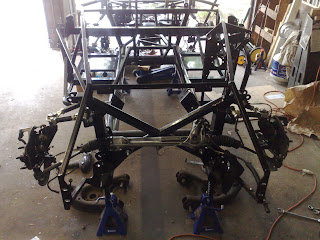In the meantime, I could work on the brakes but I am waiting for the pads to come in. It's not taking long but I am too lazy to go and and pick them up from TougeTuning. A friend of mine was planning on going there anyways and would grab my pads for me at the same time. Whenever that will be. There are a lot of the work involved with running the brake lines from the master cylinder to each wheel. But again, Whitby got the lines as part of the kit and are still not at my door step. :(
So while the parts are making their way, the real building can take place. A normal car these days is based on unibody design. That means that the frame is baked into the shell. The shell would have many other panels included. For example, firewall, floors, roof, etc. In my case, the frame is nothing more than just a frame and everything else comes separate. In fact, everything else is made of sheet aluminum panels which need to be installed together to form firewall, floors, etc.
Again, to prevent the oxidation and weakening of the aluminum I coated it with rubberized paint. Here's my paint booth, sort of:
The sun was of much help to me. I found out that the paint dries much faster in the sun, especially, being mate black. Each panel needs to be sprayed on the side that would not be otherwise covered. For instance, all the passenger compartment panels will be covered with sound deadening from the inside and don't need to be painted on that side.
The next steps are simple but laborious. First, the panel needs to be fitted to it's original spot. Then, I would trace all the supports with a sharpie. The panel is then removed and ready for mock up of the holes. The holes should be about two inches apart. I would measure the distance along one of the supports and do the math to figure out the even hole spacing. Once the holes are marked on the panel, I use a punch to ensure that drill bit does not wonder off. The next step is to drill the hole and clean the rough edges. Now the panel is ready for installation and would go back to the frame. This time I use clamps and self tapping screws to hold the panel in it's soon to be permanent position. I use the drill once again to drill the supports through the holes in the panel. The panel needs to come off one last time to allow for cleaning out the files. Also this is the time when I apply the silicone. I used Permatex clear silicone to prevent any noise from possible vibrations and to ensure that the joints are water tight. At this point the panel is ready for riveting.
Riveting is the easiest part of the job. It's kind of fun too unless the pin breaks loose and the rivet gun cannot take a grip on it. In such cases, it becomes a bit tricky but luckily it's does not happen often.
Here's the passenger foot box all done! There are in fact 1200 rivets in the supplied box. So I'd have to spend more time doing this. I did some rough math: say I spend 5 minutes on every rivet including measuring, drilling and gluing, that means I can only do 12 in an hour. Looking at the picture above you can see it takes a bit of time.
To tell the truth, I prepared a few more panels and thought that I would be able to complete the drivers side too but I realized that the firewall needs to be installed before the driver side foot box. Therefore, I need to figure out what to do with my heater which installs onto the firewall. Well, that's my next task then.



















